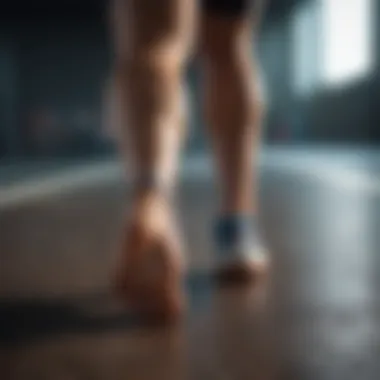Effective Strategies for Quick Shin Splint Relief


Intro
Shin splints, formally referred to as medial tibial stress syndrome, represents a common yet often misunderstood condition affecting numerous individuals engaged in physical activities. The pain and discomfort can derail training regimens and overall physical well-being. Understanding how to address this condition swiftly is crucial for anyone prone to shin splints, from recreational runners to professional athletes.
In this article, an examination of evidence-based strategies focus on both immediate relief and longer-term prevention techniques. This dual approach provides readers with a holistic understanding of managing shin splints effectively, facilitating a prompt return to regular activities.
Key Takeaways
- Shin splints are painful but manageable with the right strategies.
- Treatment involves immediate care and long-term prevention techniques.
- Taking action can lead to rapid relief and sustainable recovery.
In-Depth Analysis
Understanding Shin Splints
Shin splints occur when the muscles and bones in the lower leg are overworked. Factors contributing to this condition include poor footwear, improper running form, and sudden increases in physical activity intensity. Understanding these underlying causes is essential in addressing the issue effectively.
Research suggests that certain risk factors elevate the chance of developing shin splints. A study published in the Journal of Sports Medicine highlights that individuals with flat feet or high arches may be at greater risk.
Immediate Care Strategies
When shin splints strike, immediate care is essential. Below are several protocols to follow:
- Rest: Initially, stop the offending activity to allow the inflammation to subside.
- Ice: Apply ice packs to the affected area for 15-20 minutes multiple times a day. This decreases swelling and numbs the pain.
- Compression: Use elastic bandages to wrap the shin, which helps manage swelling.
- Elevation: Keep the leg elevated above heart level to further reduce swelling.
These measures form the foundation of initial treatment, often leading to significant improvement within a few days.
"By addressing shin splints early through immediate alleviation techniques, individuals can reduce the duration of discomfort and prevent complications."
Long-Term Preventive Strategies
Preventing shin splints requires a proactive approach. Here are some critical strategies to consider:
- Strength Training: Focus on leg and core strengthening exercises to enhance stability.
- Proper Footwear: Invest in quality shoes that provide adequate support tailored to foot type.
- Gradual Progression: Implement a stepwise increase in activity intensity, avoiding sudden jumps in mileage or pace.
- Flexibility: Regular stretching routines can help maintain muscle elasticity and readiness.
Incorporating these strategies into a fitness routine can substantially decrease the likelihood of developing shin splints in the future. Awareness of personal limits is key.
Culmination
Managing shin splints effectively requires an understanding of both immediate and long-term strategies. With informed actions and awareness of potential risks, individuals can ease discomfort rapidly and reduce chances of recurrence. The journey back to full physical activity is not only possible; it can be achieved with diligence and the right knowledge.
Understanding Shin Splints
Shin splints, also known medically as medial tibial stress syndrome, is a common affliction among athletes and active individuals. Understanding shin splints is an essential first step in managing and remedying this painful condition. The article aims to elucidate the underlying mechanisms of shin splints, including their symptoms, causes, and associated risk factors. By grasping these fundamentals, readers can make informed decisions regarding immediate care and long-term strategies for prevention.
Definition and Symptoms
Shin splints are characterized by pain along the inner edge of the shinbone, or tibia. This pain often manifests during physical activities such as running, jumping, or any weight-bearing exercise. Symptoms typically begin as mild discomfort and can escalate to sharp or throbbing pain, leading to significant difficulties in maintaining an active lifestyle. Common symptoms include:
- Pain along the shin during exercise or physical activity
- Tightness in the muscles of the lower leg
- Swelling in the lower leg
- Tenderness or soreness upon touching the affected area
If these symptoms persist, professional evaluation is advisable to prevent further damage and ensure proper treatment.
Common Causes
The emergence of shin splints can often be traced back to various underlying causes. One prevalent reason is overuse, especially in individuals who suddenly increase the intensity or duration of their exercise regimens. Additionally, poor biomechanics during physical activity can contribute significantly. Common causes encompass:


- Improper footwear, leading to inadequate support
- Hard surfaces that exacerbate impact forces on the lower legs
- Increased activity levels without adequate conditioning
- Flat feet or high arches, affecting foot alignment and weight distribution
Understanding these causes can aid in identifying personal risk factors and making necessary adjustments.
Risk Factors
Certain individuals are more predisposed to experiencing shin splints than others. Recognizing these risk factors is crucial in both the prevention and management of the condition. The main factors include:
- Athletic involvement, particularly in sports like running, basketball, and soccer
- Previous injuries in the lower legs or other related areas
- Biological factors, such as age and gender, with women often at higher risk
- Insufficient flexibility and strength in the lower leg muscles
According to health professionals, focusing on these risk factors can provide a tailored approach to both immediate relief and long-term management strategies.
In sum, the understanding of shin splints allows for a more strategic approach in addressing the condition. A clear grasp of definitions, symptoms, causes, and risk factors equips one with the essential knowledge for prompt action and recovery.
Initial Treatment Strategies
The onset of shin splints often requires immediate actions to alleviate pain and promote recovery. The section on Initial Treatment Strategies lays the groundwork for a systematic approach to managing the discomfort associated with shin splints. These strategies focus on reducing inflammation, enhancing recovery, and preventing further injury. Implementing these methods correctly can make a significant difference in the patient's healing trajectory.
Rest and Recovery
Rest is crucial for healing shin splints. Continuing to engage in high-impact activities can exacerbate the condition, prolonging recovery times. It is important to listen to your body. Reducing intensity and frequency of activities with high impact may be necessary. Recovery means more than just avoiding physical exertion; it involves allowing the muscles and tendons to recover properly. Incorporating periods of complete rest can also help restore balance and strength to the lower legs.
Ice Application
Cold therapy serves as an effective method for reducing pain and swelling associated with shin splints. Applying ice directly on the affected area can decrease inflammation by constricting blood vessels. This process helps relieve the immediate symptoms of pain. It is recommended to apply ice for 15-20 minutes every few hours. However, one must take care to avoid direct contact with the skin to prevent frostbite. Furthermore, using a cloth or towel to wrap the ice can enhance safety and comfort.
Compression Techniques
Utilizing compression wraps or sleeves can provide additional support to the shin during the healing process. Compression helps to stabilize the affected area, reducing swelling and promoting blood flow, which aids in recovery. When using compression, it is important to ensure that the wrap is snug but not overly tight. This balance is essential to avoid any circulation issues while benefiting from the stability the wrap affords.
Elevation Protocols
Elevating the affected leg while resting can significantly reduce swelling. Sitting or lying down with the leg propped up on a pillow or cushion aids in fluid drainage. Elevation helps to counteract the effects of gravity on blood flow, which can exacerbate inflammation. To maximize effectiveness, elevation should be combined with other strategies such as ice application and rest for optimal recovery.
"Combining multiple treatment strategies can accelerate recovery and reduce overall discomfort during this time."
In summary, initial treatment strategies are essential for addressing shin splints effectively. By employing rest, ice, compression, and elevation techniques, individuals can experience rapid relief and lay the groundwork for further recovery efforts.
Physical Therapy Approaches
Physical therapy plays a crucial role in the recovery and management of shin splints. It focuses on tailored techniques that target the underlying issues causing the shin pain. First, physical therapy helps in reducing pain and inflammation. Various exercises help increase flexibility and strength, which are both essential for long-term recovery. The goal of these approaches is not just to alleviate current discomfort but also to prevent future issues.
Incorporating physical therapy strategies can improve one's overall functional performance. This is especially important for athletes and individuals engaged in regular physical activity, since a timely return to their routines is often desired. The usage of specific exercises and assessment techniques allows for a more profound understanding of an individual’s biomechanics, which can lead to better outcomes.
Stretching Exercises
Stretching exercises are vital for those suffering from shin splints. They help to increase flexibility in the lower leg muscles, which can reduce tension on the shin bone. Common stretching routines focus on the calves, hamstrings, and the Achilles tendon. Engaging in regular stretching sessions can result in improved range of motion and decreased risk of injury. To perform these stretches effectively, ensure that each stretch is held for at least 15 to 30 seconds, emphasizing slow and controlled movements.
Here are some recommended stretches:
- Calf Stretch: Stand facing a wall, place your hands on it, and step back with one foot while keeping it straight. Bend the front leg slightly, feeling the stretch in the back leg.
- Toe Taps: While seated, extend one leg and lift your toes while keeping your heel on the ground. This engages the anterior muscles of the lower leg.
Regularly practicing these stretches can improve overall muscle function, making activities like running feel easier.
Strengthening Routines


Strengthening routines are also essential for addressing shin splints. Targeted strengthening helps support the muscles surrounding the shin area and can lead to enhanced stability. Focus on exercises that engage the tibialis anterior, gastrocnemius, and soleus muscles. Improved strength in these muscle groups helps disperse forces more evenly during physical activities and reduces strain on the shin bones.
Some common strengthening exercises include:
- Heel Raises: Stand with your feet flat and raise your heels, then slowly lower them down again. This works the calf muscles effectively.
- Toe Walking: Walk on your toes for 30 seconds to a minute. This enhances strength in the muscles at the front of the lower leg.
Incorporating these exercises into a daily routine fosters long-term strength gains.
Gait Analysis Techniques
Gait analysis techniques are another pillar of physical therapy for shin splints. This method involves evaluating an individual's walking or running mechanics to identify any irregular patterns. Often, improper gait can contribute to excessive stress on certain areas, including the shins. By recognizing these alterations, practitioners can suggest personalized modifications to improve efficiency.
Clinics or trained professionals can utilize both visual assessment and using advanced technology to analyze gait. Key areas of focus during gait analysis include:
- Foot Strike: Whether landing on the heel, midfoot, or forefoot influences shin stress.
- Stride Length: Examining how distance per step can affect overall impact.
Understanding your gait can lead to better choices regarding footwear and training methods, ultimately reducing the chance of recurring shin splints.
Lifestyle Modifications
Lifestyle modifications play a crucial role in managing and preventing shin splints. By making deliberate changes to daily habits, individuals can reduce the risk of recurrent pain and promote faster recovery. These modifications are not just about immediate relief; they focus on long-term strategies that integrate into one's lifestyle. The choices made in footwear, activity levels, and weight management can significantly impact the onset of shin splints.
Footwear Selection
Selecting the right footwear is essential for those prone to shin splints. Proper shoes provide the necessary support and cushioning, which can alleviate pressure on the shinbone. It is important to understand that different activities require different types of shoes. For instance, running shoes are designed for shock absorption and stability, while cross-training shoes offer support for varied movements.
When choosing footwear, consider the following points:
- Fit: Proper fitting is key. Shoes should allow for slight movement but not be too loose.
- Arch Support: Look for footwear that accommodates your arch type, whether flat, neutral, or high.
- Cushioning: More cushioning is often required for high-impact activities to absorb shock.
"Investing in quality footwear is investing in your health."
Activity Modifications
Modifying activity levels can significantly impact shin splints. Reducing high-impact activities while incorporating low-impact exercises can help manage symptoms. For example, swimming or cycling can maintain fitness while reducing the strain on shins.
Gradually increasing activity levels after a period of rest is important. Implementing cross-training can also diversify workouts and avoid overuse injuries. Here are some recommendations:
- Limit High-Impact Activities: Temporarily decrease running or jumping exercises.
- Incorporate Low-Impact Exercises: Engage in swimming, elliptical training, or cycling.
- Rest and Recovery: Ensure that recovery days are part of your routine, allowing the body to heal.
Weight Management Strategies
Maintaining a healthy weight can play a vital role in preventing shin splints. Extra weight increases the stress on the lower legs during physical activity, increasing the likelihood of injury.
Implementing sensible eating habits and regular physical activity can assist in weight management. Here are some strategies to consider:
- Balanced Diet: Focus on whole foods, including vegetables, fruits, proteins, and whole grains.
- Portion Control: Be mindful of portion sizes to maintain a healthy caloric intake.
- Regular Exercise: A consistent exercise routine helps manage weight effectively.
Advanced Treatment Options
When traditional treatments for shin splints do not provide adequate relief, advanced treatment options may be necessary. These strategies often offer targeted solutions designed to reduce pain, improve mobility, and aid in recovery. Such methods can be beneficial for individuals who engage in intense physical activity or for those whose shin splints are persistent. In this section, we will explore some of the most effective advanced treatment options.
Orthotic Devices
Orthotic devices serve as supportive insoles that can be custom-made or bought over-the-counter. These devices can help correct biomechanical issues that lead to shin splints. Individuals who have flat feet or high arches might find that orthotics considerably improve their comfort levels during physical activities.


Key benefits of using orthotic devices include:
- Enhanced Comfort: By providing better arch support, orthotics can relieve the pressure on the shin muscles.
- Improved Biomechanics: They help align the foot and leg in a way that reduces stress on the shin bone.
- Injury Prevention: Using proper orthotic support may prevent future occurrences of shin splints.
However, it is crucial to consult a professional before selecting orthotic devices. Options vary significantly, and personalized fitting ensures optimal results.
Ultrasound Therapy
Ultrasound therapy is a non-invasive technique that uses sound waves to promote healing in affected tissues. This method is particularly useful for reducing inflammation associated with shin splints.
The mechanism of ultrasound therapy involves:
- Increased Blood Flow: It enhances circulation in the injured area, accelerating the healing process.
- Pain Reduction: The therapy can alleviate pain by targeting deep tissue without causing harm to the skin.
- Soft Tissue Healing: It can also stimulate the repair of muscle and tendon tissues.
This therapy often requires multiple sessions to observe significant improvements. It is recommended to work with a licensed physical therapist familiar with ultrasound applications to ensure effectiveness.
Extracorporeal Shockwave Therapy
Extracorporeal shockwave therapy (ESWT) involves sending acoustic waves to the injured area to stimulate healing. This advanced method is gaining popularity in sports medicine due to its non-invasive nature.
Advantages of ESWT include:
- Non-Invasive: It eliminates the need for surgical intervention, making it a safer option for many patients.
- Reduced Pain: Many individuals report decreased pain levels after just a few sessions.
- Promotes Healing: The shockwaves can boost cellular repair mechanisms in the injured tissues.
Doctors generally recommend this therapy when other strategies have failed. A thorough assessment is critical to determine if ESWT is suitable for a patient’s specific condition.
"Incorporating advanced treatment options can significantly enhance recovery times and improve overall outcomes for individuals suffering from shin splints."
Overall, advanced treatment options provide informed pathways for individuals struggling with shin splints. These methods complement basic care strategies and incorporate modern technology to address the problem more effectively. Engaging with health professionals for appropriate advanced methods can ensure a tailored recovery experience.
Preventive Measures
Preventive measures play a crucial role in managing and reducing the risk of shin splints. They are not merely additional practices but essential components of a comprehensive strategy aimed at addressing the underlying issues that lead to shin splints. By implementing preventive measures, individuals can maintain an active lifestyle while minimizing the probability of injury. The significance of these strategies lies in their potential to enhance overall athletic performance, promote longevity in physical activities, and decrease the frequency of setbacks due to pain.
Warm-up and Cool-down Practices
Incorporating proper warm-up and cool-down practices is fundamental for anyone engaging in physical activities. Warm-ups prepare the muscles and joints for exercise, gradually increasing heart rate and blood flow. This can include dynamic stretches such as leg swings or walking lunges. Conversely, cool-down practices help to prevent muscle stiffness and fatigue. Static stretches targeted at the lower body should be included to maintain flexibility. Focusing on these processes can help in avoiding injuries, including shin splints.
Gradual Increase in Activity Levels
A common mistake made by athletes and fitness enthusiasts is the abrupt increase in intensity or duration of workouts without adequate adjustment. To avoid this, a gradual increase in activity levels is vital. This means slowly adding mileage if you are a runner or incrementally boosting workout intensity. The 10% rule, which suggests not increasing your training load by more than 10% per week, is a widely accepted guideline. Allow the body to adapt, ultimately leading to improved performance and a lower risk of overuse injuries such as shin splints.
Cross-training Benefits
Cross-training serves as an effective method for preventing shin splints and other injuries. By engaging in varying types of exercises, one can avoid overtraining specific muscle groups that contribute to shin splints. Activities such as swimming, cycling, or yoga can improve overall fitness while reducing impact on the shins. Moreover, cross-training keeps workouts fresh and enjoyable, potentially enhancing overall motivation and commitment to fitness goals. Deliberate incorporation of different physical activities can result in well-rounded strength and less repetitive stress on the shins, ultimately reducing injury risks.
"Cross-training not only enhances physical fitness but also creates a buffer against injuries by varying stress on the body."
The End
A well-rounded understanding of shin splints is crucial. Readers can benefit from recognizing the importance of immediate care, such as rest and ice application coupled with long-term preventive measures that reduce recurrence chances. Key strategies highlighted include rigorous initial treatment, appropriate footwear selection, and the significance of proper warm-up practices. All these components collaborate to create a solid foundation for relief and recovery.
In addition, encouraging individuals to consult healthcare professionals cannot be overstated. This backing provides access to tailored advice and ensures that underlying issues contributing to shin splints are addressed effectively.
Summary of Key Strategies
- Immediate Self-Care: Engaging in rest, ice application, and compression can significantly alleviate pain.
- Physical Therapy: Implementing stretching and strengthening exercises is crucial for recovery.
- Proper Footwear: Choosing the right shoes can offer enhanced support and comfort.
- Monitoring Activities: Adapting one’s activity levels and incorporating cross-training can mitigate risks of reinjury.
Encouragement to Seek Professional Advice
It is vital to understand that while home treatments can be effective, professional input can often lead to better outcomes. Health professionals possess the experience to assess specific conditions, offering targeted solutions thus enabling a more rapid and effective recovery. Moreover, creating a definitive plan may involve diagnostic tools or tailored therapeutic interventions that are beyond self-directed efforts. Seeking advice from qualified experts fosters a holistic approach, further minimizing risks associated with unfounded remedies and enhancing overall well-being.







